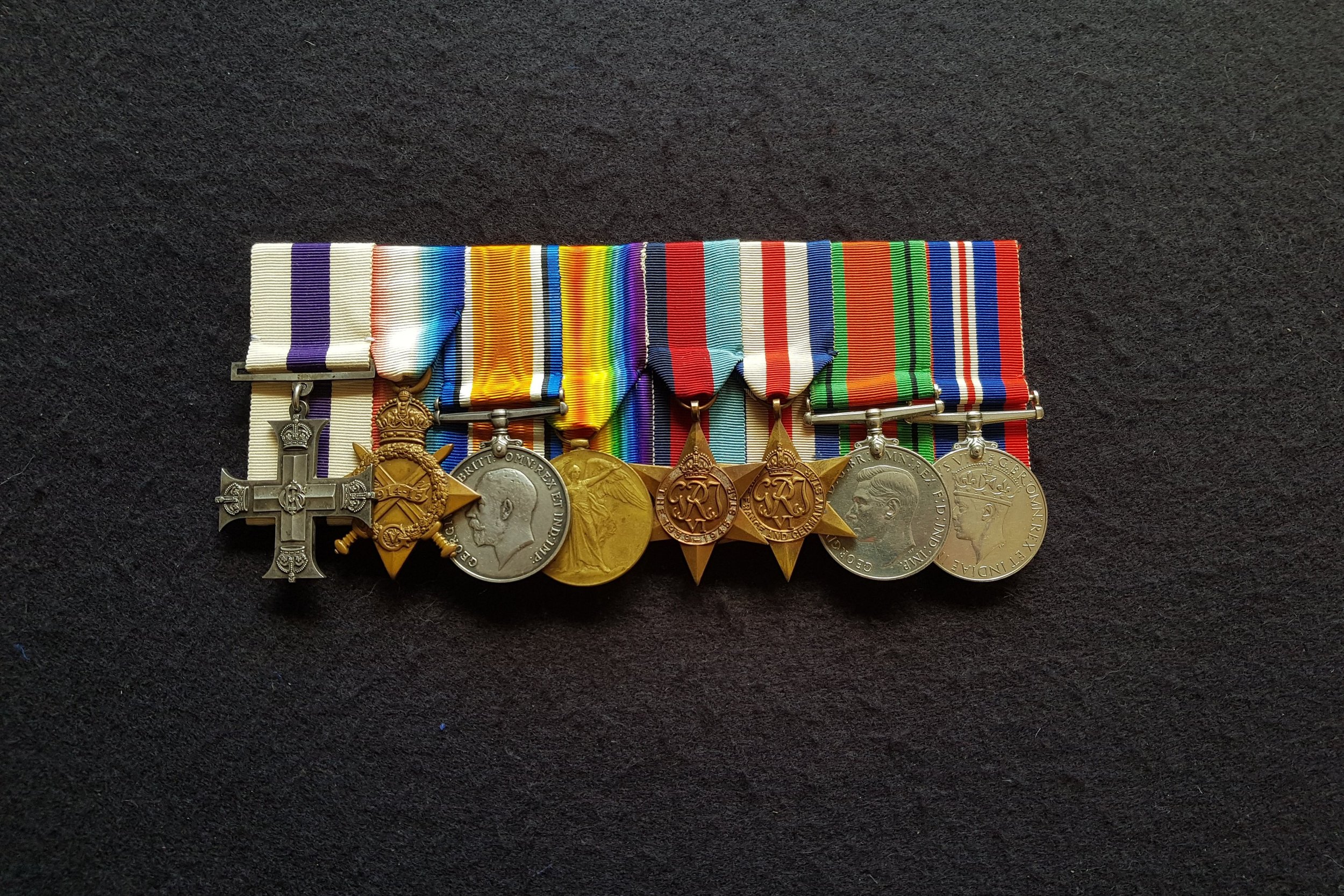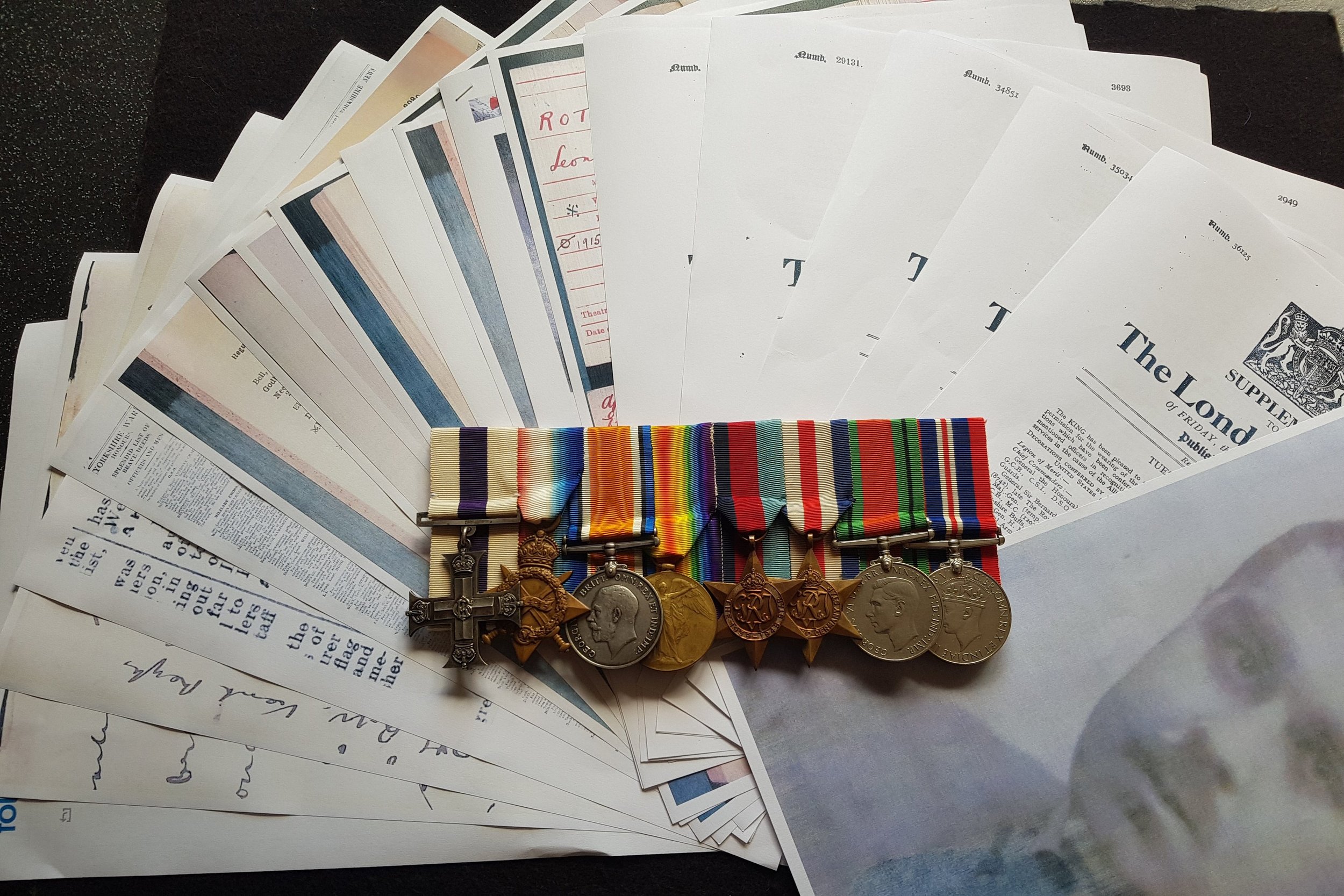A Very Good WW1 'Thiepval Offensive' M.C., W.I.A., & WW2 'Fall of France/Dunkirk Evacuation' Medal Group to Captain L. Rothery, 7th West Riding Regiment, later 2/5th Leicester Regiment (1452)






















A Very Good WW1 'Thiepval Offensive' M.C., W.I.A., & WW2 'Fall of France/Dunkirk Evacuation' Medal Group to Captain L. Rothery, 7th West Riding Regiment, later 2/5th Leicester Regiment (1452)
A Very Good WW1 'Thiepval Offensive' M.C., W.I.A., & WW2 'Fall of France/Dunkirk Evacuation' Medal Group awarded to Captain L. Rothery, 7th West Riding Regiment, later 2/5th Leicester Regiment.
Leonard Rothery was born on 12 July 1897 in Huddersfield, the eldest son of Major William Umpleby Rothery, Duke of Wellington's Regiment, the managing director of Joseph Sykes Bros Ltd., card clothing manufacturers. Rothery Sr. also served in the First World War, reaching the rank of Major.
Rothery was commissioned Second Lieutenant on 24 August 1914 from the Bradfield College Training Corps and posted to the 7th Battalion, Duke of Wellington's (West Riding Regiment). Further advanced Lieutenant on 15 March 1915, he entered the war on 15 April and was soon serving with the 6th (Cyclist) Battalion, Suffolk Regiment.
Returning to his own Regiment he was promoted Captain while commanding a Company on 9 October 1915, winning the M.C. during the Thiepval Offensive (Battle of Flers-Courcelette, the Somme). Rothery was confirmed Captain in 1917 and was severely wounded in action in 1918. The citation reads as follows -
'For conspicuous gallantry in action. He led his Company with great determination, and captured a portion of the enemy's position which had resisted several previous attacks.'
M.C. London Gazette 14 November, 1916.
The Duke of Wellington’s West Riding Regiment raised 23 Battalions, was awarded 63 Battle Honours and 5 Victoria Crosses, losing 7,870 men during the course of the First World War.
1/4th 1/6th & 1/7th Battalion Territorial Force
04.08.1914 The 1/4th stationed at Halifax, the 1/6th stationed at Skipton-in-Craven and the 1/7th stationed at Milnsbridge all as part of the 2nd West Riding Brigade of the West Riding Division and then moved to Hull and Grimsby as part of coastal defences.
05.11.1914 Moved to Doncaster.
14.04.1915 Mobilised for war and landed at Boulogne.
12.05.1915 The formation became the 147th Brigade of the 49th Division which engaged in various actions on the Western front including;
1915
The Battle of Aubers Ridge, The defence against the first Phosgene attack.
1916
The Battle of Albert, The Battle of Bazentin Ridge, The Battle of Pozieres Ridge, The Battle of Flers-Courcelette.
1917
Operations on the Flanders Coast (Hush), The Battle of Poelcapelle.
1918
The Battle of Estaires, The Battle of Messines, The Battle of Bailleul, The First Battle of Kemmel Ridge, The Second Battle of Kemmel Ridge, The Battle of the Scherpenberg, The pursuit to the Selle, The Battle of the Selle, The Battle of Valenciennes.
11.11.1918 Ended the war at Auby north of Douai, France.
The 1st/7th West Riding Regiment carried out it's first major offensive at Thiepval on the 17th September 1916, as part of the Battle of Flers-Courcelette. Prior to this, the battalion had been 'in support' or 'in reserve'. The assault on the German trenches was a major success and all objectives were taken, but the casualties sustained were heavy compared with earlier engagements.
“The assault was made in four waves at intervals of fifteen, twenty and fifteen feet, the unit being a Platoon. A Bomb Squad, consisting of one NCO and eleven other ranks, accompanied each half Company, and every man in the last two waves carried either a pick or a shovel. Report Centres, main and subsidiary, Battalion scouts, and other special parties were detailed for duty, and all Troops were reported in position at 6 pm. Nearly everything went right, except that a portion of D Company, including both Lewis guns and their detachments, were believed to have advanced towards the Row of Apple Trees, and were either taken prisoner or wiped out by machine gun fire. About 7 o’clock reports were received that the objective had been captured, though it was doubtful how the left flank had fared. The total casualties in this little action were five officers and 215 other ranks.”
After the war he settled in Huddersfield, marrying there in 1922 and appearing at 98 North Road in a 1927 directory. With the onset of the Second World War Rothery was commissioned on 1 April 1940 in the Leicester Regiment, serving with the 2/5th Battalion. They were part of the third advance party, joining the BEF in May,1940.
The German forces attacked on 10 May 1940, with air attacks and parachute landings in the Netherlands, and a land invasion into both the Netherlands and Belgium. The King of the Belgium’s officially asked for military assistance, so the British and French forces advanced into Belgium to take up positions on the line of the River Dyle. The German forces gained three bridgeheads across the River Meuse on 14 May, allowing them to sweep through from the Ardennes into northern France. The 2 Panzer Division reached Abbeville on 20 May 1940, effectively isolating the B.E.F. and French 1 and 7 Armies. On 21 May, British armoured units counter attacked at Arras, to try to force a way through the German lines, but failed to do so. The B.E.F. fell back towards Dunkirk, with major battles between 23 and 28 May at St. Omer, and between 26 and 28 May 1940 along the Ypres – Comines Canal.
The German advance could not be contained, with Boulogne falling on 25 May 1940, and Calais on 27 May 1940, despite heroic defence by British and French forces. Operation Dynamo was launched on 27 May 1940 to rescue the B.E.F. from the Dunkirk area. Before the town was captured by the Germans on 4 June 1940, about 210,000 British servicemen and 120,000 French soldiers had been evacuated successfully.
He transferred to the Border Regiment, and then the Royal Engineers, serving with them until July 1945. Rothery died in Cobham, Surrey on 31 May 1953.
His brother, Major Geoffrey Rothery, 3rd Parachute Brigade, was killed in action on the 10th of March, 1943, serving in Tunisia
The medals are mounted for display, sold with a file of copied research, a copy of ‘The Tigers at Dunkirk, by Matthew Richardson, and are as follows -
Military Cross, G.V.R., engraved on the reverse 'Presented by H. M. King George V to Capt L. Rothery At Buckingham Place June 26th 1919'; 1914 -15 Star, LIEUT. L. ROTHERY W. RID. R.); British War and Victory Medals, CAPT. L. ROTHERY); 1939-45 Star; France and Germany Star; Defence and War Medals 1939-45
Condition, Very Fine